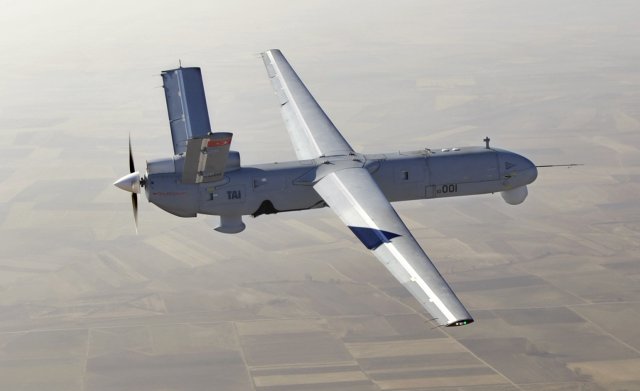 When Turkey’s military planners grasped more than a decade ago the virtues of unmanned aircraft systems (UAS) mostly in their asymmetric warfare against Kurdish separatists, the country was solely dependent on imported aircraft. Later, the dependency on UAS grew exponentially and the Turks decided to build their own. They are still thriving.
When Turkey’s military planners grasped more than a decade ago the virtues of unmanned aircraft systems (UAS) mostly in their asymmetric warfare against Kurdish separatists, the country was solely dependent on imported aircraft. Later, the dependency on UAS grew exponentially and the Turks decided to build their own. They are still thriving.
Industry experts and analysts agree that the UAS market in Turkey would flourish in the near future, but before that the local industry must make a successful debut.
Turkish procurement authorities said in March that they are preparing to sign a contract for the acquisition of 10 locally made systems, dubbed the ANKA. “All eyes are on the ANKA contract,” said one source. “Once the ANKAs have started to successfully operate, the Turks will order scores of more, including armed UAS.”
But a procurement official said the contract may be delayed for a short period more because of a snag concerning the targeting pod. “If the locally developed pod does not fit our specifications, we may opt for a foreign pod,” he said.
Turkey’s biggest defence company, Aselsan, has been designing and developing the ASELFLIR 235 for the ANKA.
The contract will mark Turkey’s first official purchase of UAS designed, developed and manufactured indigenously. Turkish Aerospace Industries (TAI), based here and the maker of the ANKA, has said the Turkish UAS successfully passed acceptance tests late in January.
The final, decisive tests on Jan. 20-21 involved a full-endurance, 18-hour flight, successful auto landing, data link performance at a distance of 200 kilometers under winds of up to 45 knots, as well as night takeoffs and landings.
The ANKA has so far completed more than 150 flight hours. There is a possibility that TAI could develop a satellite-controlled version of the ANKA, company officials said.
Police to order ANKA
Meanwhile, procurement officials said the Turkish police force is also preparing to place an order for the ANKA which means more funding for “fine-tuning efforts” as part of the program.
The ANKA is a medium-altitude long-endurance MALE-category UAS which can operate for 24 hours at an altitude of 10,000 feet.
ANKA, meaning Phoenix in English, is the first MALE-type UAS to be produced by TAI. Presently, several prototypes have been produced with other engines. One of the prototypes crashed during a test flight in September 2012 but several other flight tests have been carried out successfully. ANKA+, another version of the ANKA, calls for an armed vehicle, using a rocket attached to its body and sensors.
These efforts do not mean foreign suppliers are entirely outside the picture. “There is a lot Turkey needs to buy from specialist companies abroad,” said one London-based Turkey analyst.
Turkish officials often look pleased to portray the ANKA as a “fully Turkish, national, purely indigenous aircraft,” but the aircraft boasts imported engine, automatic take-off and landing system, landing gear and radio. The targeting pod could just be added to the list.
The procurement official said success with the ANKA project would lead to an exponential growth in Turkey’s UAS market. “We have been patiently waiting for this aircraft to come out neat and clean,” he said. “We have invested a lot of time and resources that we cannot start from scratch. Once it enters the inventory, new orders would boom.”
“I think the Turks are waiting for the ANKA before placing more generous orders of UAS of all sorts, whether built entirely in Turkey or with various combinations of imported parts,” The London-based analyst said.
Two privately owned defence companies have also been actively working on their own UAS to catch up with future demand in the market.
 Baykar has developed a mini UAS, the Gözcü; and a tactical UAS, the Çaldıran. The nine-meter wingspan, carbon-kevlar composite body Çaldıran can fly broadcast from a range of 200 kilometers and reach an altitude of 22,000 feet. Fitted with thermal cameras, its normal cruising speed is 70 knots and maximum takeoff weight is 450 kilograms, including fuel.
Baykar has developed a mini UAS, the Gözcü; and a tactical UAS, the Çaldıran. The nine-meter wingspan, carbon-kevlar composite body Çaldıran can fly broadcast from a range of 200 kilometers and reach an altitude of 22,000 feet. Fitted with thermal cameras, its normal cruising speed is 70 knots and maximum takeoff weight is 450 kilograms, including fuel.

Vestel Defense’s Karayel is an unmanned aircraft system designed for aerial observation. The Karayel was developed in 2007 and began test flights in 2009. Remote sensing systems on board are able to detect a target and mark for laser-guided munitions. All phases of the flight, take-off, landing and flight profile are performed autonomously. Its payload bay is configurable for military and civilian applications. Vestel has also developed a mini UAS.
Photos: 1 – ANKA 2. Caldiran 3. Karayel
Source: Hurriyet Daily News
